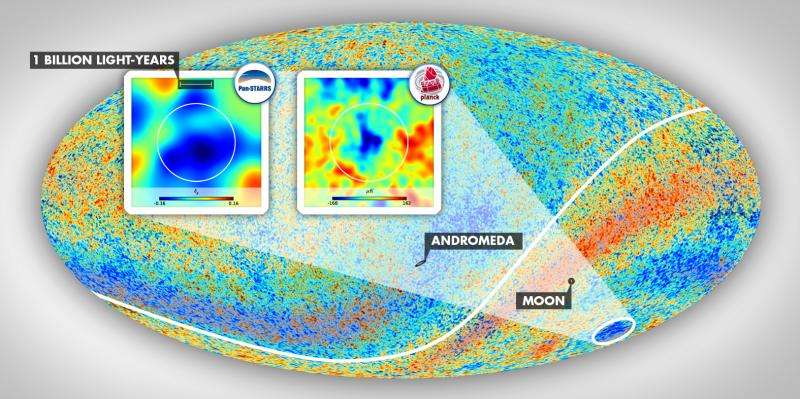
Some of the most intriguing cosmological mysteries don’t involve strange objects like black holes or neutron stars. The best mysteries may not even affect our everyday lives, or leave gaping holes in our scientific models (*ahem* dark energy).
Sometimes, questions arise when there’s a lack of something, which brings us to voids—large “holes” in space that aren’t just absent of things we can see, but completely empty (of mostly everything). While some contain a few random galaxies, the vast majority don’t have stars, galaxies, planets, clusters, stellar material, or any other visible matter—including dark matter, the enigmatic substance that makes up a large chunk of the universe. Our own Milky Way galaxy, which is a member of the Local Group, actually lies at the edge of one of these voids—called the “local void.”
Form and Void:
The idea is this: In the earliest moments of creation—merely fractions of a second after the universe was thrust into existence by the big bang—spacetime almost immediately ballooned in size. We’ve since learned that during this short-lived phase, know as “inflation,” matter was not distributed equally because of cosmic fluctuations. Consequentially, certain areas of space are more dense than others, resulting in voids, supervoids, and their polar opposites: galaxies, clusters and galaxy superclusters. We can see the fluctuations in matter density throughout the universe, but our observations make the most sense in the context of the cosmic microwave background radiation (CMB): the big bang “afterglow.”

In studying the map, astronomers noted that, around 10 billion light-year away, toward the constellation of Eridanus, the CMB shows evidence of an unusually large cold spot. To explain why this portion of space has a slight —yet discernible—temperature difference, astronomers ascribe the cold spot to a void. Not just any void, but the largest in existence by far—stretching out about one billion light-years in diameter.
They postulate that the cold spot was created when the microwaves from the CMB pass through a huge void on their way toward Earth. We already know that the voids can have an effect on microwaves that pass through them—just as they are when they pass through dense galaxy superclusters, except with the opposite effect. Basically, when they traverse denser regions—places teeming with traditional and nontraditional matter—the microwaves gain energy from the pull of gravity. Whereas, when they pass through a void, gravity doesn’t impart any extra energy on them, for gravity is a consequence of matter, and how it warps the fabric of spacetime. Ergo, the CMBR appears cooler. However, the supervoid solution comes with a major problem: standard cosmology models say such a huge void should not be possible.
Imagine there is a huge void with very little matter between you (the observer) and the CMB. Now think of the void as a hill. As the light enters the void, it must climb this hill. If the universe were not undergoing accelerating expansion, then the void would not evolve significantly, and light would descend the hill and regain the energy it lost as it exits the void. But with the accelerating expansion, the hill is measurably stretched as the light is traveling over it. By the time the light descends the hill, the hill has gotten flatter than when the light entered, so the light cannot pick up all the energy it lost upon entering the void. The light exits the void with less energy, and therefore at a longer wavelength, which corresponds to a colder temperature.
Getting through a supervoid can take millions of years, even at the speed of light, so this measurable effect, known as the Integrated Sachs-Wolfe (ISW) effect, might provide the first explanation one of the most significant anomalies found to date in the CMB, first by a NASA satellite called the Wilkinson Microwave Anisotropy Probe (WMAP), and more recently, by Planck, a satellite launched by the European Space Agency.
While the existence of the supervoid and its expected effect on the CMB do not fully explain the Cold Spot, it is very unlikely that the supervoid and the Cold Spot at the same location are a coincidence.
[Reference: University of Hawaii at Manoa]
Doorway to Other Realms?
Not everyone thinks the cold spot is a void. For instance, one researcher believes it may be an imprint of another universe, which would belong to a larger multiverse. Laura Mersini-Houghton, the leading proponent of this theory, has suggested that this region came about through a form of quantum entanglement—spooky action at a distance, as Einstein called it— that occurred between our universe and the parallel universe prior to their separation (perhaps during inflation).
It’s interesting to note that if this hypothesis holds up, there would be evidence in the form of a “mirror” supervoid located in the opposite hemisphere. Strangely enough, in 2009, a void that seems to fit the bill was discovered in the southern hemisphere. However, it might be of little consequence, being that there is no consensus on exactly where this mirror void should be.

Another theory (one that is is admittedly absurd), was proposed by Lawrence Rudnick (from the University of Minnesota). He puts forth the notion that the Eridanus void is not a conventional void at all, but a ‘universe-in-mass’ black hole that consumed all matter in its vicinity. Furthermore, he and his team believe that dark energy, the force responsible for the accelerating expansion of the universe, is but an illusion brought on by the gravitational effects of an immensely large—not to mention, very powerful—black hole that lies at the very edge of our observable universe.
Of course, perhaps the cold spot isn’t a void at all. For that matter, there’s a chance the cold spot itself never existed in the first place (though new research suggests that’s unlikely). Either or, these structures are fascinating.